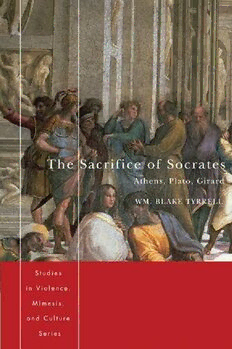Table Of ContentT S
he acrifice
S
of ocrates
Studies in Violence, Mimesis, and Culture
SERIES EDITOR
William A. Johnsen
Th e Studies in Violence, Mimesis, and Culture Series examines issues related to the nexus of
violence and religion in the genesis and maintenance of culture. It furthers the agenda of the
Colloquium on Violence and Religion, an international association that draws inspiration
from René Girard’s mimetic hypothesis on the relationship between violence and religion,
elaborated in a stunning series of books he has written over the last forty years. Readers
interested in this area of research can also look to the association’s journal, Contagion: Journal
of Violence, Mimesis, and Culture.
EDITORIAL BOARD MEMBERS
Rebecca Adams, Independent Scholar Mark Juergensmeyer, University of California,
Mark Anspach, École Polytechnique, Paris Santa Barbara
Ann Astell, University of Notre Dame Cheryl Kirk-Duggan, Shaw Divinity School
Cesáreo Bandera, University of North Carolina Michael Kirwan, SJ, Heythrop College, University
Maria Stella Barberi, Università di Messina of London
Benoît Chantre, L’association Recherches Paisley Livingston, Lingnan University,
Mimétiques Hong Kong
Diana Culbertson, Kent State University Charles Mabee, Ecumenical Th eological Seminary,
Paul Dumouchel, Ritsumeikan University Detroit
Jean-Pierre Dupuy, Stanford University, École Józef Niewiadomski, Universität Innsbruck
Polytechnique Wolfgang Palaver, Universität Innsbruck
Giuseppe Fornari, Università degli studi di Bergamo Martha Reineke, University of Northern Iowa
Eric Gans, University of California, Los Angeles Tobin Siebers, University of Michigan
Sandor Goodhardt, Purdue University Th ee Smith, Emory University
Robert Hamerton-Kelly, Stanford University Mark Wallace, Swarthmore College
Hans Jensen, Aarhus University, Denmark Eugene Webb, University of Washington
T S
he acrifice
S
of ocrates
Athens, Plato, Girard
Wm. Blake Tyrrell
Michigan State University Press · East Lansing
Copyright © 2012 by Wm. Blake Tyrrell
i Th e paper used in this publication meets the minimum requirements of ANSI/NISO
Z39.48-1992 (R 1997) (Permanence of Paper).
pMichigan State University Press
East Lansing, Michigan 48823-5245
Printed and bound in the United States of America.
18 17 16 15 14 13 12 1 2 3 4 5 6 7 8 9 10
library of congress cataloging-in-publication data
Tyrrell, William Blake.
Th e sacrifice of Socrates : Athens, Plato, Girard / Wm. Blake Tyrrell.
pages. cm. — (Studies in violence, mimesis, and culture series)
Includes bibliographic references and index.
ISBN 978-1-61186-054-2 (paperback : alkaline paper) 1. Socrates. 2. Plato—Criticism and
interpretation. 3. Girard, René, 1923– 4. Athens (Greece)—History—Th irty Tyrants, 404–403
b.c. 5. Greece—History—Peloponnesian War, 431–404 b.c. I. Title. II. Series: Studies in
violence, mimesis, and culture.
B316.T97 2012
183’.2—dc23
2011050523
Book by Charlie Sharp, Sharp Des!gns, Lansing, Michigan
Cover design by David Drummond, Salamander Design, www.salamanderdesign.com
Cover art is a detail from School of Athens, from the Stanza della Segnatura, 1510-11 (fresco)
(detail of 472) by Raphael (Raff aello Sanzio of Urbino) (1483-1520) located in Vatican Museums
and Galleries, Vatican City, Italy. Image courtesy of Giraudon, Th e Bridgeman Art Library.
G Michigan State University Press is a member of the Green Press Initiative and
is committed to developing and encouraging ecologically responsible publishing
practices. For more information about the Green Press Initiative and the use of recycled paper in
book publishing, please visit www.greenpressinitiative.org.
Visit Michigan State University Press at www.msupress.org
For Larry Joe Bennett
April 1, 1949–April 20, 2006
Son, Brother, Soldier, Husband, Father, Pa, Nephew,
Uncle, Cousin, Friend, Colleague
Contents
ix Preface
xi Introduction
1 chapter 1. Mimesis, Conflict, and Crisis
41 chapter 2. Plato’s Victimary Culture
73 chapter 3. Aristophanes’ Ready Victim
91 chapter 4. Foundation Murder
151 Notes
175 Bibliography
185 Index
Preface
I
n the late 1980s Larry Joe Bennett and I began researching the Socrates of
Plato’s Apology of Socrates as a pharmakos figure. Encountering resistance
to our nonhistorical approach, we turned to Aristophanes’ Knights,
whose underlying structure we believed was that of the pharmakos. Aft er
overcoming prejudices against the Cambridge School, whose “heresies” we
were charged with reviving, we published our study of Knights in Arethusa
(1990). In the meantime, our interest had shift ed to the influence of funeral
oratory in Sophocles’ Antigone. By the time that we had worked out our
interpretation in Recapturing Sophocles’ Antigone (1998) and were out from
under the weight of accepted knowledge about the play, we had been away
from the Socrates idea for some fift een years. We were getting back to it when
one morning in April of 2006 Joe died. With him perished the direction
that the study would have taken. I returned to the hypothesis of René Girard
that proved to be useful in reading Sophocles’ Ajax (Arethusa 1985) and
Antigone (Contagion 2009). From there, I moved to the present endeavor,
an essay of Plato’s project from the perspective and methodology of Girard’s
mimetic mechanism. It is intended as a contribution to Girardian studies
and, in particular, his theories on the origin of culture in mimetic rivalry and
victimization. In what follows, I attempt to apply René Girard’s theory, his
ix

